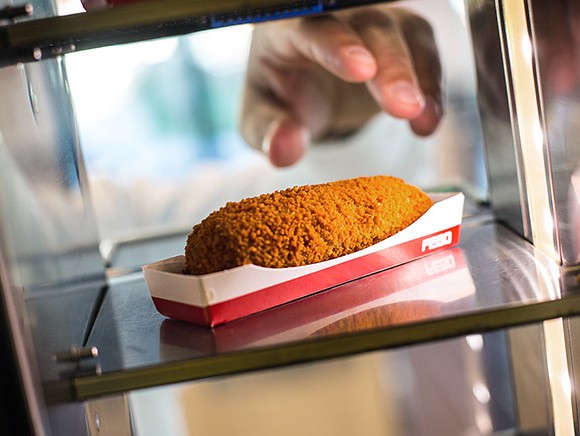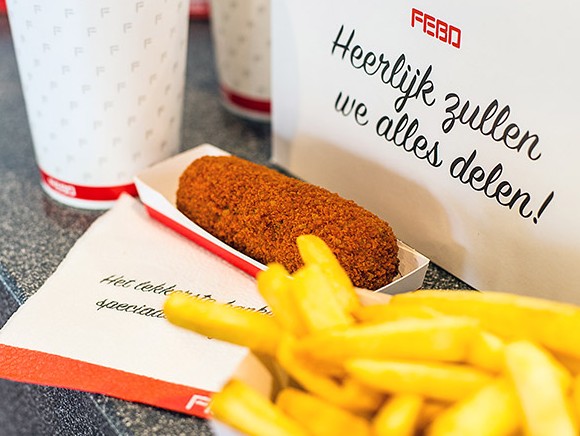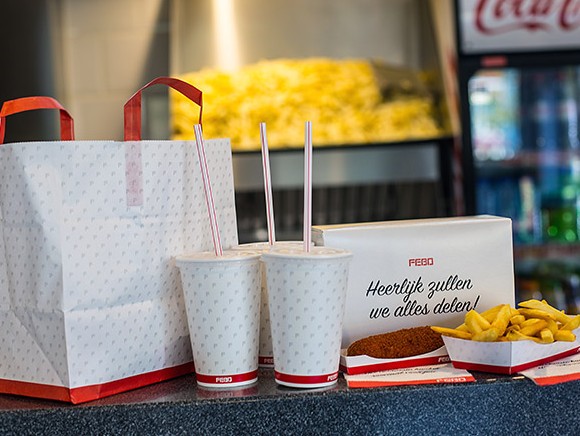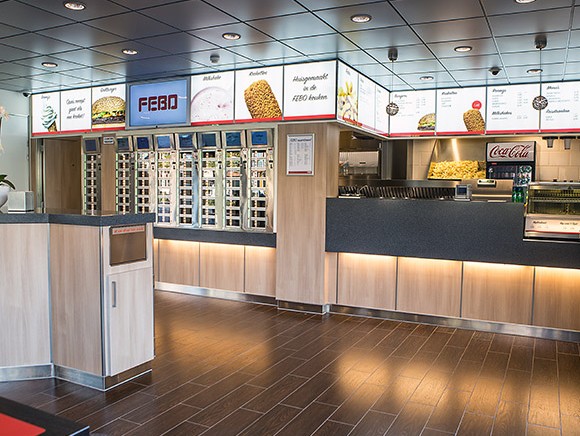
“Consumers nowadays have such a wide choice so we have to set ourselves apart in several different ways,” says Ferry Stevens, who is responsible for quality at Febo and was closely involved in the brand’s recent upgrade. “Among other things, we do that by further improving the way we convey the authentic Febo story – which is a story of freshly made high-quality products every day and traditional craftsmanship.”
Anyone who walks down Leidsestraat in Amsterdam, for example, can plainly see that competition in the city centre is increasing. “The market is changing, consumers are changing and therefore we’re changing too,” comments Ferry Stevens. That’s the reason why Febo introduced a new house style at the end of last year. All 67 outlets of the vending-machine-based fast-food chain were revamped to give them a more luxurious image and an ultra-modern style which expresses the artisanal quality of the snacks more effectively. The familiar brand colours of red and yellow were replaced by a more serene-looking combination of white and red, and the lettering, text and images were updated.
The new handwriting-style font has a more personal appearance and underlines the fact that food on the menu has been prepared in a traditional manner by – and for – people. The transformation project got underway in October and all outlets had been converted to the new look by the end of November 2015. The new house style was a bold step because Febo had been associated with the colour yellow for many decades. Another aspect that has been renewed is the packaging, which is now made from certified sustainable (FSC) cardboard in white and red and subtly displays a double F for Febo. “A considerable quality improvement,” is how Stevens describes the chic new printed packaging. The new packaging has proved a success in several ways. “Some of our customers are health-conscious. They watch their salt, fat and calorie intake, but they feel that the occasional fast-food meal can still be part of a balanced and healthy diet. However, our consumer research revealed that they were strongly against plastic packaging so we’ve removed those concerns with our new cardboard packaging.” It also seems to be an advantage that people are used to idea of recycling cardboard. Much more of the packaging now ends up in Febo’s bins rather than as litter on the street. “The amount of waste we collect has risen by 40%.” That’s important for the company because it is keen to run its business sustainably and maintain a good relationship with the relevant government authorities.
‘We still remain an authentic bakery to this day’

Another new element introduced in Febo’s consumer communication at the end of year has been ‘Grandfather’. The new slogan, which translates as ‘Grandfather’s recipe goes like a croquette’, is now displayed in all its outlets as a playful way of underlining Febo’s rich, 75-year history. After all, while the house style has been updated, the traditional method of making the high-quality products fresh every day has not changed. Those products are always manufactured based on the company’s own unique formulations, largely in line with the carefully preserved recipes of Johan de Borst, the company founder and grandfather of current director Dennis. Johan trained as a pastry chef at a bakery on Ferdinand Bolstraat in Amsterdam. When he opened his own bakery elsewhere in the city in 1941, he named it after that street. In the 1960s he started making croquettes and other snacks and selling them in his bakery too. Stevens, who himself is a trained patissier: “We still remain an authentic bakery to this day, even though we have 67 outlets.”

The outlets can place their orders at the production facility in the north of Amsterdam every day until 4 a.m. By that time, the meat and the stock for the ragout, made with traditional herbs and spices, have been cooking for hours. The ragout forms the heart of the croquette, just as the croquette forms the heart of the Febo business. The meat in the croquettes comes from animals raised at one of six different Dutch farms. “We’ve been working with all of them for years. We know that their animals have a good life; we impose strict criteria in terms of animal welfare.” The animals are slaughtered in Amsterdam, at the abattoir on Jan van Galenstraat, and have been supplied to the company by Kouwenhoven Vlees for the past 40-plus years. Febo has control over the entire chain for all products – including for the snacks that are not manufactured in-house, such as the kaassoufflés (cheese fritters). Everything in the product range is manufactured in line with Febo’s recipes, up to and including the ice cream that Febo has developed in conjunction with a dairy farmer.

At 4 a.m., when the final orders have been received, the production activities get underway. “In essence, the production process is still just like it was in grandfather’s day, with the ragout rolled in chicken protein and breadcrumbs. But he made the products by hand, completing 40 an hour. With help from our equipment, we now produce 10,000 an hour.” Every day, around 50,000 products roll off the lines of the manufacturing facility in Amsterdam. Over the course of the morning, five lorries set off from the premises to deliver the freshly made croquettes and other snacks to the vending-machine-based outlets across the country. As Stevens says: “You can’t get fresher than that.”
Source: © Ondernemers Sociëteit Voedingsindustrie